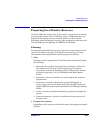
Disaster Recovery
Assisted Manual Disaster Recovery of a Windows System
Chapter 10450
Assisted Manual Disaster Recovery of a
Windows System
The following sections explain how to prepare and execute an Assisted
Manual Disaster Recovery on Windows systems. For details on
supported operating systems, refer to the HP OpenView Storage Data
Protector Software Release Notes.
Assisted Manual Disaster Recovery is an elementary method that
consists of the following steps:
1. Installing the Windows NT operating system temporarily (temporary
DR OS) or installing other Windows systems to its original location
(active DR OS). This includes the creation and formatting of the boot
and system partition, needed for the Windows installation.
2. Creating and formatting additional partitions as they existed on the
crashed system, including original drive letter assignments.
3. Executing the Data Protector drstart.exe command, which will
install a temporary Data Protector suite and start the restore of the
system critical volumes.
4. Booting the system and deleting the Windows NT temporary
installation.
5. Recovering the vendor-specific partition, if it existed before the
disaster.
NOTE The preparation and recovery procedure are different for the recovery of
a Data Protector client and of a Data Protector Cell Manager. The
differences are marked in the text.
Note that Windows provide additional possibilities to recover a system
before deciding on a disaster recovery. This can be done by booting the
system in the safe mode or from the recovery floppy disks and trying to
resolve problems. Another option is to start the computer using the last
known good configuration.


















